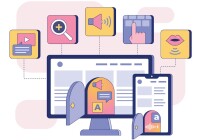Search
There are 17 results.
Category
Tag
Tag
All (33)
Alt Text (1)
Assessments (2)
Belonging (3)
Canvas (2)
Color Contrast (1)
Communication (2)
Community (2)
Content Creation (12)
Course Materials (9)
Course Preparation (3)
Diversity (4)
Equity (2)
Faculty Presence (1)
Faculty Support (1)
Formative Assessments (1)
Images (1)
Inclusion (8)
Page Design (1)
PowerPoint (1)
Representation (2)
Rubrics (1)
Screen Readers (1)
Synchrony (1)
Universal Design for Learning (UDL) (3)
Video (2)
Visual Accessibility (2)
Best Practices to Support Student Well-Being
Mental health concerns are prevalent among undergraduate and graduate students and can have deleterious consequences (Chi et al., 2023; Venable & Pietrucha, 2022). In particular, students struggling with their mental health are less likely to pass their courses and more likely to drop out of their programs of study (Lister & McFarlane, 2021). While universities often provide support systems in the form of accessibility services and counseling centers, several significant issues can lead to the underutilization of available resources among students in general and online students in particular. First, students may need to be physically present on campus in order to access support systems (Lister et al., 2023). As a result, students enrolled in online programs may be unable to use them. Additionally, students may not capitalize on available resources due to logistical challenges (e.g., scheduling), feelings of discomfort in asking for help, or concerns about stigmatization (Venable & Pietrucha, 2022).
No Sweat Alt Text
What is “alt text”? Alt text is descriptive text linked to an image, graph, or other visual content that allows users to understand the visual without viewing it. Any image online should contain alt text, but guidelines differ depending on whether the image is simply decorative or related to other content on the page.
Best Practices for Online Office Hours
Office hours, blocks of time designated for faculty and student interaction outside of any regularly scheduled class sessions, are routinely incorporated into university courses (Briody et al., 2019; Hsu et al., 2022). Such sessions are often semi-structured and optional for students, allowing faculty to provide customized support to individual learners when needs arise. This form of faculty-student interaction can support academic achievement, retention, and engagement (Griffin et al., 2014; Guzzardo et al., 2021). That office hours attendance is often at the discretion of individual students, however, can result in underutilization of this valuable supplement to required course sessions and contents (Briody et al., 2019; Griffin et al., 2014; Smith et al., 2017). The purpose of this blog is to delineate empirically guided strategies for optimizing the inclusion of office hours in university courses. In particular, we focus on office hours hosted online, as the online modality can be advantageously employed not only for courses delivered online but also for those delivered residentially.
Two-Stage Extensions: When a Canvas Quiz Has Limited Attempts and an Availability Date
When a Canvas quiz has a limited number of attempts and an availability date, there are two sets of actions instructors usually need to take to provide a student with an additional attempt or extension on the quiz. First, the instructor will need to add a new quiz attempt for the student. Second, if the availability date has passed or is about to pass, they will need to extend the availability of the quiz. This short guide will walk you through both stages of the process.
Offering Extensions in Canvas
Due dates are a useful pedagogical tool. They help students keep pace to complete the course, populate the To-Do List and Calendar with reminders for both instructors and students, and allow Canvas to work more predictably and efficiently, among other benefits. However, there inevitably come times when a student needs a different time frame than the standard allotment to complete work. This guide will help walk through the considerations needed to extend the due date on an assignment. (Note: Extending the due date of an assignment, discussion, or quiz is different than adding additional attempts at the work. For more information on adding attempts, see the Envision piece Two-Stage Extensions: When a Canvas Quiz Has Limited Attempts and an Availability Date.)
Ten Ways to Open the Gate to Accessibility
According to the United States Census Bureau, over 57 million Americans, nearly one in five people in the U.S. population, report living with a disability. To make certain all your students can have a successful learning experience, it is important to take steps to make the online learning environment accessible. Here are 10 strategies for making your online course space accessible to all users.
Accessible PDFs
Developing and delivering accessible instructional content—meaning content that students with and without disabilities can readily engage with and use—is essential to the success of an online course. While many accessibility standards and guidelines are broadly applicable, there are also specific considerations unique to different content formats and delivery modes. In this piece, we present recommendations for enhancing the accessibility of PDFs for students.
Accessible Use of Color
Some students (older learners, learners with partial sight, learners with color blindness, and learners using monochrome or text-only displays) have difficulty perceiving color. To ensure that course content is perceivable to all learners, you should follow the color use guidelines that have been established by the World Wide Web Consortium (W3C), the organization responsible for international standards of web accessibility, including the Web Content Accessibility Guidelines (WCAG). Three essential WCAG requirements, known as success criteria, are summarized below.
Spreadsheet Accessibility
Spreadsheets are used for a broad array of data-related tasks and projects across numerous disciplines. Maximizing the utility of spreadsheets as course materials requires careful attention towards their content and formatting. In this piece, we present recommendations for enhancing the clarity, consistency, and accessibility of course spreadsheets for students.










